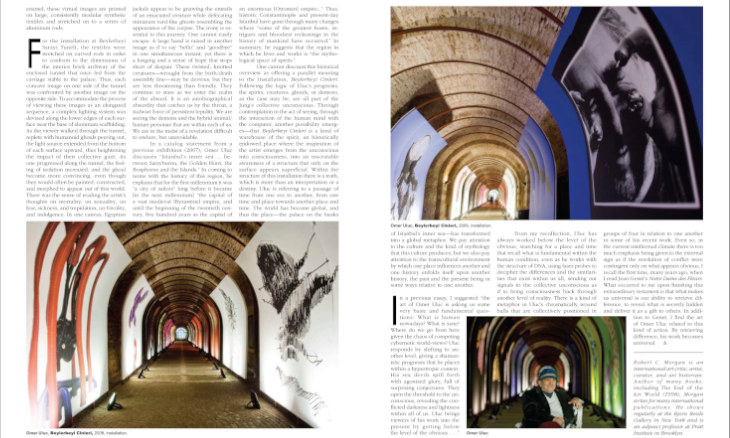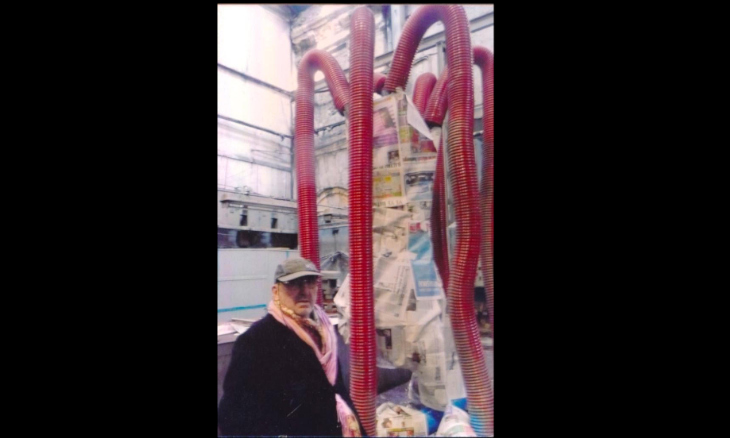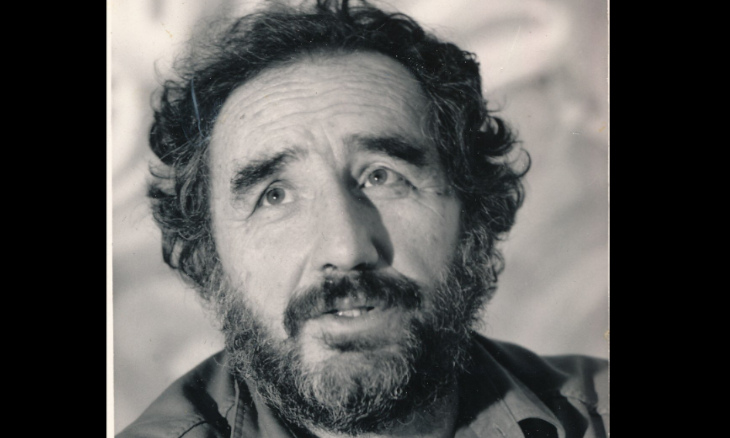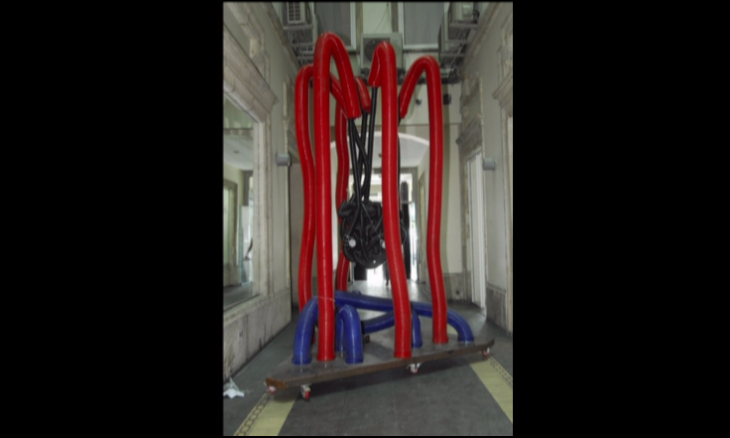The mystery of the bat sculpture of Turkish artist Ömer Uluç
The "Yarasa", or bat sculpture by Turkish artist Ömer Uluç was last seen in 2009. It has since disappeared. Uluç's wife Vivet Kanetti, a prominent intellectual and writer, sheds light on the mystery.
How could a sculpture be lost? When, where and with whom was the Yarasa [bat] sculpture last seen?
Vivet Kanetti Uluç: How can a sculpture, especially a sculpture with the dimensions of the bat sculpture be lost? This really is a chilling question. There are many of us these days attempting to find logical answers to this maddening question. The bat (Yarasa) was last seen - in three dimensions -in 2009 at Istanbul’s Tepebaşı, in the inner court of the Nu Pera building. Artist Ömer Uluç had two young friends, both architects, Murat Tabanlıoğlu and his wife Melkan Tabanlıoğlu. He knew Murat sihce he was a child. Their architectural office was in the building. Sculpture Bat (Yarasa) was placed in the inner court as their guest. Ömer Uluç was preparing digital works for his “Beylerbeyi Cinleri” [Beylerbeyi Jinns] exhibition in September 2009. The sculpture was made in 2006. He repainted the image of the sculpture to include it in that exhibition. Its photographs were taken for Beylerbeyi Cinleri and the sculpture was taken to Nu Pera court.

The Beylerbeyi Jinns Exhibition is an interesting milestone in the artist’s production. Back in 2009 I had written that he uploaded his 50-year long production into a space ship. “This is like a scored goal of theory to life, like a huge goal with the images he reproduced in the digital environment. It is an anti-conformist move. Uluç’s creatures were like a chorus, enjoying not being permanent. Like their master Ömer Uluç. When I asked him that, he had answered: “As you'd say in card games, I shuffled the cards.”
Vivet Kanetti Uluç: Yes, that interview was very interesting. It was a time, between 2008 and 2010, when a rapidly developing disease was being fought. Every month, every week, even every day was considered as a gain. Ömer would dedicate all the time that was gained to new works, he never stopped. While Ömer was alive, after a few months spent showcasing the sculpture, they told us they had removed Yarasa (Bat) to their storehouse in order for it not to be damaged. After his death, Melkan repeated, “You should feel fine; you know we have the sculpture.” Yarasa (Bat) was not a sculpture that would fit ordinary-sized apartments. Many people from the art world knew that the sculpture was entrusted to them. From that day on, the response of Murat Tabanlıoğlu to all those who asked was “The sculpture is in the storage.” In short, in the eyes of every one of us, Yarasa (Bat) was secured at a place where it was protected at its best. Until a serious culture institution wished that the sculpture should not only stay at a safe place but rather displayed at a place where it can meet old and new generations...
What did you hear exactly?
Vivet Kanetti Uluç: It turned out that the Tabanlıoğlu couple did not have a storage facility in that building. They had two flats. And all of a sudden, the name “Muzaffer” started to be uttered, manager of the building Nu Pera, Muzaffer Yıldırım. He had storage facilities, but they were outside the building. Sculpture Yarasa (Bat) was loaded onto trucks and transferred to one of his storehouses! All of this has happened without us being informed, without asking our opinion, without asking for permission and without having anything registered in written form in their architectural offices. No note such as, “this sculpture has been handed over to this manager, was moved with this truck and this driver to the storage in this neighbourhood.” In short, those people whom a sculpture has been entrusted have entrusted the same sculpture to another person. The answers we (and many others from the art world who love Ömer Uluç) receive from them are such as: “It has been a long time. We have searched all our storages in the city. There is no sculpture…” And there is a detail: “Some kind of plastics.”
I want to open a parenthesis here: Ömer has worked with ropes in his transmission into three dimensions from his own movement. His figures with ropes were molded into aluminum in his first large sculpture, later into polyester. Since 2006, he continued doing his polyester molded sculptures, while at the same time, as in the Yarasa (Bat) example before that, he directly used plastic material. This is a choice. He explained the reasons of this choice to Cem Erciyes, in his book Wandering Cape of Hope, “In sculptures prepared by using PVC, polyester and plastic material, there are no marble and metal surfaces. By not using them, I am trying to distance myself from other sculptors and the Renaissance tradition. I call more of a three dimension in them.”

The reason I opened and closed this parenthesis is this: destroying an art piece is not an action of negligence. It needs exertion, time and will. I still do not want to believe that anybody in this country would easily be engaged in such a vandalistic action. Our entrusted friends handed over the sculpture, without us knowing about it, to other entrusted people we do not know and maybe to others… Let's assume that these people did not realise the value of this art piece. But still, this thought must have crossed their minds: “Ok, I might see this pile of plastics, but breaking up this huge structure, dismembering it and even throwing it away requires enormous labor and time. This huge work that I do not value could constitute a value for others. How can I take responsibility for destroying and disposing it?”
If you are able to ask yourself such a question, then it is not possible for you to move the sculpture from one place to another without any registration, without informing anybody. Neither can you approach the issue with “It has been a long time…”
If the entrustment of an art piece is in question, what could it mean to say “It has been a long time…”
 Ömer Uluç
Ömer UluçWhat do you plan to do to search for and find this loss?
Vivet Kanetti Uluç: I strongly believe that there has been an unwanted gap on the chain that was established to protect this art work and that this gap will soon be filled and all of us will receive good news. I don’t want to think anything else. Otherwise, it would be unacceptable not only for Ömer Uluç and his appreciators, but for all of us.
Certain possibilities have crossed my mind when the option of exhibiting the sculpture Yarasa(Bat) in a cultural institution came up. One of them was, “we have taken such good care of the sculpture that we should also have a say in which institution it will be showcased.” Or perhaps another demand, “Leave it to us. Let us have Yarasa(Bat).” Or, “Allow us to display it in one of the buildings we are designing. I pondered over these possibilities. The only thing I haven't considered was “It has been a long time. I wonder where Yarasa(Bat) is now?”
It is impossible not to think this lost sculpture as a symbol. In the name of the cruelty adopted against cultural heritage, in the name of those dozens of negligence and dysfunctional relationship with cultural heritage…
Vivet Kanetti Uluç: Of course, this also comes to mind. The evaporation of Yarasa (Bat) is another one of these traumas that we cannot come to terms with. These destructions are gradually becoming a tradition. Not being able to protect values, the mentality of “It has been a long time, we can do a better one” is as contagious as the coronavirus. It has infiltrated all segments of society. Nobody is exempt from this destructive wave. Despite this, I strongly believe that we will receive the news of Yarasa(Bat) having been found.
I would like to bring up the file you wrote for Artpress magazine in 1991 with regards to the moral rights of the artist. What does this file point to in this recent case of the loss of a giant statue in today’s Turkey?

Vivet Kanetti Uluç: In several European countries, the moral rights of the artist is a more long-lasting right than copyright, it is eternal. There is the example of the French Culture Minister Jack Lang's order for Daniel Buren columns in the Palais Royal in Paris. His successor François Léotard did not want them. The lawyer of Buren said if the columns had not started being built, then it would have been only monetary compensation. “But since the production of the installation had started, it was about to be completed, we were on stronger ground. We fought for the moral rights of the artist.” The public debate went on and eventually the new culture minister agreed to the completion and placement of the installation. The case was closed before it was taken to court.
Another very impressive case is the huge statue the Renault factory had ordered to Dubuffet in 1973. The general manager of the factory changed in 1975 and he did not want it anymore. The model was already done. There was a clause in the contract that in the case where the project was cancelled, the artist would not ask for compensation. Despite this, Dubuffet took the case to court, mobilizing many other artists and collecting signatures. Museums from all around the world reacted. He wrote in 1977 that he would not allow the prosperous bosses to insult his work. The case was appealed. In 1983, a Versailles court ordered Renault to complete the sculpture. Dubuffet won. He then used his right to refuse to complete the statue. In 1985, the French state ordered Dubuffet the “Tour aux figures” which was completed in 1988, placed right across Renault headquarters. I prepared a file with such examples but of course I never thought we would one day experience a similar case.
*This article is concurrently published at SanatAtak, an Istanbul based independent website on arts, culture and everything about life. Duvar English welcomes the collaboration of SanatAtak for coverage of arts scene in Turkey. Turkish version of the article can be reached here.

